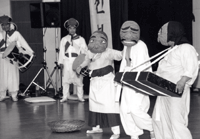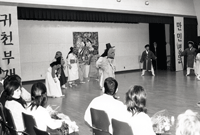Mask Dance Performance in Osaka
The Osaka Liaison Conference for the Universal Declaration of Human Rights invited a mask dance company called the Jinju Okwangdae Preservation Association from Korea to Japan at the end of April. The mask dance company presented the play entitled "Paekjung" at two different halls in Sumiyoshi and Izumi, both located in Osaka Prefecture. The Paekjung are an oppressed people in Korea. Because of the very severe discriminati on against them, Paekjung stood up against their oppressors, formed an association called "Hyongpyong-sa" and initiated a liberation movement in Jinju, Gyeong Sang Nam Do, in 1923, one year after Buraku people founded the National Levelers Association in 1922. During that time, the two organizations communicated with one another to building international solidarity links. The Hyongpyong-sa celebrated its 81st anniversary on April 24 this year, though the organization itself no longer exists.
on against them, Paekjung stood up against their oppressors, formed an association called "Hyongpyong-sa" and initiated a liberation movement in Jinju, Gyeong Sang Nam Do, in 1923, one year after Buraku people founded the National Levelers Association in 1922. During that time, the two organizations communicated with one another to building international solidarity links. The Hyongpyong-sa celebrated its 81st anniversary on April 24 this year, though the organization itself no longer exists.
The mask dance traces its origins back to the 19th century. It peaked in the middle of the 19th century when the Chosong Dynasty was coming to a close. This was also the time when society was thrown into confusion with the slow collapse of Confucian traditions and the class system. The mask dance was a form of entertainment of and for the masses that performed the dance wearing masks in order to satirize social problems and contradictions. Jinju was one of the places where the mask dance flourished.
The traditional themes of the mask dance are exorcism, satirical dances regarding depraved monks and the yanban class (the aristocrats during the feudal periods), and the love affairs and daily lives of ordinary people. The mask dance is usually accompanied by a traditional samurunori band, which is mostly comprised of various types of drums.
The Jinju Okwangdae performed the Paekjung play, focusing on the poverty, oppression and discrimination suffered by Paekjung. Paekjung were confined in certain remote villages in poor geographical conditions and were forced to wear specific types of clothing. Their sources of incomes were limited to that generated from the slaughtering industry. Children were not allowed to go to schools if they were Paekjung and yanban did not even face any consequences for killing Paekjung.
 Paekjung, however, refused to continue to suffer under the injustice, discrimination and oppression. They stood up to liberate themselves and organized the Hyongpyong-sa that initiated the liberation movement. In the climax of the drama, Paekjung were full of joy and pride with the emergence of a new era for them.
Paekjung, however, refused to continue to suffer under the injustice, discrimination and oppression. They stood up to liberate themselves and organized the Hyongpyong-sa that initiated the liberation movement. In the climax of the drama, Paekjung were full of joy and pride with the emergence of a new era for them.
The audience, who had never heard of Paekjung before, were deeply moved by the story. They found that Paekjung and Buraku people shared the same patterns of discrimination, social injustice and inequality. The drama reminded them of the foundation of the Levelers Association.
Byung-Hoon Jeong, the Chairperson of the Jinju Okwangdae Preservation Association and a Professor of Gyeong Sang University, said, "I sincerely hope that our mask dance performance will help promote cultural exchange between Japan and Korea, and human rights movements for the elimination of discrimination in both countries."
